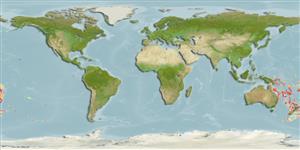Klassifizierung / Names
Namen | Synonyme | Catalog of Fishes(Gattung, Arten) | ITIS | CoL | WoRMS | Cloffa
Holocephali (Chimären, Seekatzen) (chimaeras) >
Chimaeriformes (Chimaeras) >
Chimaeridae (Shortnose chimaeras or ratfishes)
Etymology: Hydrolagus: hydro-, combining form of hydor (Gr.), water; lagos (Gr.), hare, i.e., “water rabbit,” probably referring to three pairs of tooth plates, which tend to protrude from the mouth like a rabbit’s incisors (See ETYFish); marmoratus: Latin for marbled, referring to marbled pattern of greyish brown reticulations on sides (See ETYFish).
Environment: milieu / climate zone / depth range / distribution range
Ökologie
seewasser bathydemersal; tiefenbereich 548 - 995 m (Ref. 76967). Deep-water
Western Pacific: Australia.
Length at first maturity / Size / Gewicht / Alter
Maturity: Lm ?, range 60 - ? cm
Max length : 80.1 cm TL Männchen/unbestimmt; (Ref. 76967)
Kurzbeschreibung
Bestimmungsschlüssel | Morphologie | Morphometrie
This chimaeroid fish has a ventral caudal fin that that is not indented at its origin to form a separate anal fin and is distinguished from its congeners by the following characters: color of body pale brown with prominent reticulations on sides, dorsal fin and spine whitish basally; the dorsal-fin spine is slightly shorter than or subequal in height of first dorsal fin, while the pelvic fins somewhat rectangular in shape (not broadly rounded); pelvic claspers of males are
mostly pale, divided for the distal 2/3 of their length (Ref. 76967).
Life cycle and mating behavior
Geschlechtsreife | Fortpflanzung | Ablaichen | Eier | Fecundity | Larven
Didier, D.A., 2008. Two new species of the genus Hydrolagus Gill (Holocephali: Chimaeridae) from Australia. In Last, P.R., White, W.T. & Pogonoski, J.J. (eds.): Descriptions of New Australian Chondrichthyans. CSIRO Marine and Atmospheric Research Paper no. 22. (Ref. 76967)
IUCN Rote Liste Status (Ref. 130435: Version 2024-2)
Bedrohung für Menschen
Harmless
Nutzung durch Menschen
Tools
Zusatzinformationen
Download XML
Internet Quellen
Estimates based on models
Preferred temperature (Ref.
123201): 5.1 - 8.6, mean 6.8 °C (based on 133 cells).
Phylogenetic diversity index (Ref.
82804): PD
50 = 0.5000 [Uniqueness, from 0.5 = low to 2.0 = high].
Bayesian length-weight: a=0.00331 (0.00137 - 0.00798), b=3.07 (2.86 - 3.28), in cm total length, based on LWR estimates for this (Sub)family-body shape (Ref.
93245).
Trophic level (Ref.
69278): 3.9 ±0.6 se; based on size and trophs of closest relatives
Widerstandsfähigkeit (Ref.
120179): niedrig, Verdopplung der Population dauert 4,5 - 14 Jahre. (Deepwater species with few large eggs.).
Fishing Vulnerability (Ref.
59153): Moderate to high vulnerability (52 of 100).
